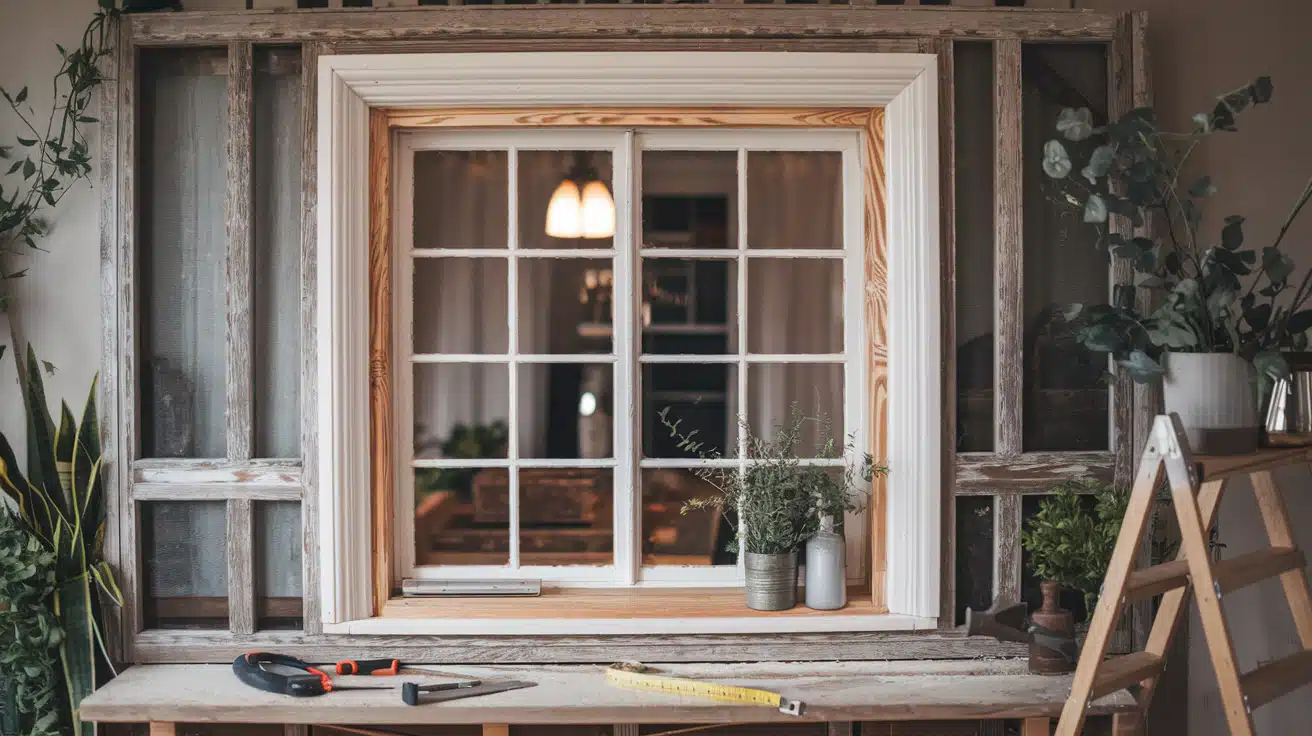Plain windows make rooms feel incomplete. Your home deserves better than factory-standard window frames that lack character and charm.
Those bare edges around your windows create a missed opportunity in your living space. You notice how they fail to match your design vision each time you look at them.
Ready for good news? You can change all that this weekend. This guide will walk you through adding farmhouse window trim to your home.
You’ll learn which materials work best, how to measure correctly, and the exact steps to install trim that looks professional.
We’ve broken everything down into simple steps anyone can follow, even if you’ve never held a saw before.
Let’s build something beautiful together!
Why Consider Farmhouse Style Window Trim
Window trim does more than fill empty wall space. It creates a focal point in any room. Plain windows often look unfinished, but adding trim instantly upgrades their look and feel.
Farmhouse-style trim stands out with its clean lines and simple design. The style works well in both modern and traditional homes.
Its straight edges and modest details add character without overpowering other design elements in your space.
The cost savings make DIY trim projects worth your time. Professional window trim installation can cost $200-500 per window, but doing it yourself cuts that price by 70-80%.
With basic tools and materials costing $50-100, you can trim multiple windows for the price of one professional job.
Beyond savings, making your trim builds useful skills. Each cut and nail creates a sense of pride. You’ll feel genuine satisfaction each time you look at your completed work. That feeling can’t be bought.
Plus, DIY projects let you control every detail. You choose the exact width, style, and finish that fits your vision.
Tools and Materials Required for DIY Farmhouse Window Trim
Tools and Their Purpose
| TOOL | PURPOSE |
|---|---|
| 16-gauge finish nailer | Secures boards with precision |
| Measuring tape | Ensures accurate cuts and placement |
| Level | Check the alignment of trim pieces |
| Miter saw or circular saw | Cuts trim boards to precise measurements |
| Caulk gun | Applies caulk evenly |
| Paintbrush or roller | Used for even paint application |
Materials and Their Purpose
| Material | Purpose |
|---|---|
| 1×4 boards | The main structure for bottom, side, and top trim |
| 1×6 board | Part of the top section for layered design |
| 1×2 boards | Adds depth to the top trim |
| Thin molding strips (1 inch by ½ inch) | Covers gaps for a clean finish |
| 2½ inch finish nails | Stronghold for trim pieces |
| Wood filler | Fills nail holes for a smooth finish |
| Sandpaper | Smooths out wood filler and rough edges |
| Primer | Prepares wood for painting |
| Paint | Adds color and protects the trim |
| Caulk | Seals gaps for a flawless appearance |
Step-by-Step Installation Guide For Farmhouse Window Trim
The right approach makes all the difference when adding window trim. Follow these steps for great results:
Step 1: Install the Bottom Piece
Start with the foundation of your window trim. Cut a 1×4 board that extends beyond where the side pieces will go. Position this piece so it sits completely flush with your windowsill.
Use a 16-gauge finish nailer with 2½ inch nails to firmly secure it. Aim your nails into the framing around the window for maximum holding power.
Step 2: Attach Side Trim
Next, focus on the vertical elements of your trim. Cut two 1×4 boards to match your window height precisely. Position each piece flush against the side jamb of your window.
Secure them with your finish nailer, checking for level as you work. These side pieces create the main vertical lines of your farmhouse trim look.
Step 3: Create the Top Section
The top section requires three separate pieces for a layered effect. Begin with a 1×2 board positioned on its side, extending 1 inch past the side trim on both ends.
Nail each end down into the side trim. Next, add a 1×6 board, aligning it exactly with the edges of your side trim with no overhang. Secure with nails into both the wall and the first layer.
Complete with another 1×2 with a 1-inch overhang on each end, nailing down from the top.
Step 4: Add Finish Molding
Add thin molding strips where the trim meets the window for a truly finished look. Cut pieces about 1 inch by ½ inch and press them tight against the window frame.
This step covers gaps between the casing and window, giving a clean, professional appearance. Secure these small pieces with finished nails for a seamless look.
Step 5: Finishing Work
Complete your project with proper finishing. Prime any raw wood sections that weren’t pre-primed. Once dry, fill all nail holes with wood filler and sand smooth after it dries.
Apply caulk to every joint and seam, smoothing it with your finger for a clean line. Finally, paint the entire trim assembly with your chosen color for a cohesive, finished appearance.
Check out the YouTube video on DIY Farmhouse Interior Window Trim by Country Girl Living for a visual tutorial.
Farmhouse Window Trim Maintenance Tips
- Clean your window trim with a damp cloth and mild soap every 2-3 months to prevent dust buildup.
- Keep a small amount of your trim paint for quick touch-ups when chips or scratches occur.
- Check for caulk cracks once per season, especially after temperature changes.
- Tighten any loose trim with new nails when needed rather than waiting for bigger issues.
- Look for water damage signs during rainy seasons, particularly on window sills.
- Apply a fresh coat of paint every 3-5 years to maintain the finish and protect the wood.
- Treat any small wood damage promptly to prevent moisture from causing bigger problems.
- Keep window areas dry to extend the life of your trim work.
- Use soft cloths when cleaning to avoid scratching the paint surface.
- Inspect the trim and window seal twice yearly to catch any separation issues.
Common Mistakes to Avoid
Many DIYers rush measuring, causing gaps or too-short trim. Always measure twice and cut once. Use a proper square for corners and write down all measurements.
Pick straight boards without knots, especially for longer pieces. Pre-primed wood saves time and creates a better paint finish. MDF may be cheaper but fails in humid areas. Check that lumber width stays consistent.
Skipping level checks creates crooked trim. Using too few nails means loose trim later. Not marking stud locations leads to poor attachment. Rushing corners results in hard-to-hide gaps.
Skipping primer causes blotchy paint. Not filling nail holes fully leaves dimples. Cheap caulk creates cracks within months. Rushing dry time leads to uneven color. Applying paint too thickly causes hard-to-fix drips.
Conclusion
Window trim gives your home a finished, personal touch. By following our steps, you’ve learned how to create farmhouse-style window trim that looks professional.
Remember the key points: measure carefully, select quality materials, install pieces in the correct order, and take time with the finishing touches. The small details make the biggest difference.
Why does this matter? Because your home should reflect your style, not just what came standard. DIY trim saves money and gives you control over the final look.
What next? Try trimming one window this weekend. Take before and after photos to see the difference.
Share your results in the comments below, or ask questions if you hit a snag. Your next window upgrade is just a few cuts away!













